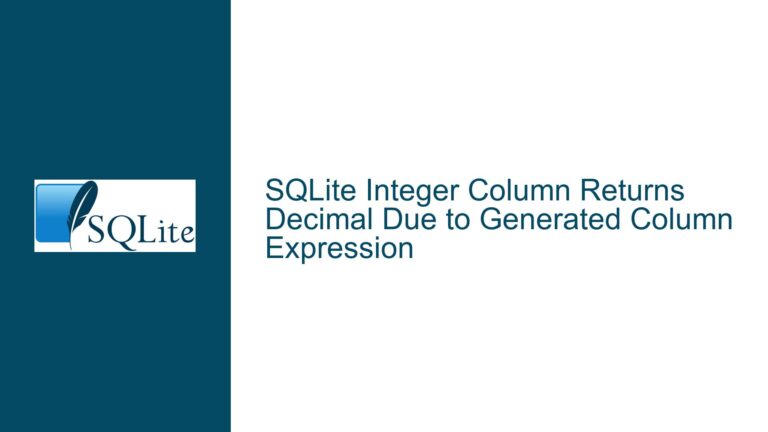Enforcing Uppercase and Numeric Constraints in SQLite
SQLite Check Constraints for Uppercase and Numeric Validation
When designing a database schema in SQLite, ensuring data integrity is paramount. One common requirement is to enforce constraints on text fields to allow only specific characters, such as uppercase letters and numeric digits. This is particularly relevant in scenarios like storing Vehicle Identification Numbers (VINs), which typically consist of uppercase letters and numbers. The challenge lies in implementing a robust check constraint that validates the input against these criteria without relying on external extensions or complex logic.
The primary issue revolves around creating a check constraint that ensures a text field, such as a VIN, contains only uppercase letters (A-Z) and numeric digits (0-9). The constraint must be efficient, reliable, and ideally independent of external dependencies like the REGEXP extension. This requirement is critical for maintaining data quality and preventing invalid entries that could lead to downstream issues in applications relying on this data.
Limitations of LIKE and GLOB in Enforcing Character-Specific Constraints
The initial approach using the LIKE operator in SQLite falls short due to its inherent limitations. The LIKE operator is designed for pattern matching with wildcards (% and _), but it cannot enforce a strict character set constraint. For example, the expression VIN NOT LIKE '%[A-Z0-9]%' does not work as intended because it matches any sequence of characters containing at least one uppercase letter or digit, rather than ensuring the entire string consists solely of these characters.
Similarly, the GLOB operator, which supports more advanced pattern matching with wildcards (* and ?), also fails to meet the requirement. While GLOB can match specific patterns, it lacks the ability to enforce a strict character set constraint across the entire string. This limitation necessitates alternative approaches to achieve the desired validation.
Implementing Check Constraints with Regular Expressions and Custom Logic
One effective solution involves using the REGEXP extension, which provides robust support for regular expressions. By leveraging the REGEXP operator, you can create a check constraint that ensures the entire string consists only of uppercase letters and numeric digits. The regular expression ^[A-Z0-9]+$ matches strings that contain one or more characters, all of which must be uppercase letters or digits. This approach is both concise and reliable, provided the REGEXP extension is available.
However, if the REGEXP extension is not available or you prefer to avoid external dependencies, a custom solution using SQLite’s built-in functions can be implemented. This approach involves using a combination of GLOB, Hex, ZeroBlob, and Replace functions to dynamically generate a pattern that enforces the constraint. The key idea is to create a pattern that matches only strings composed of uppercase letters and digits by replacing each character in the string with the [A-Z0-9] pattern.
For example, the expression Vin GLOB Replace(Hex(ZeroBlob(Length(Vin))), '00', '[A-Z0-9]') dynamically generates a pattern that matches strings of the same length as Vin, where each character is an uppercase letter or digit. This approach ensures that the entire string adheres to the required character set without relying on external extensions.
Additionally, it is essential to include a check for the length of the string to ensure it is not empty. The expression length(vin) > 0 ensures that the string contains at least one character, preventing empty strings from being inserted into the table.
Detailed Troubleshooting Steps and Solutions
Step 1: Evaluate the Use Case and Requirements
Before implementing any constraints, it is crucial to understand the specific requirements of the use case. In this scenario, the goal is to enforce a constraint on the Vin column to allow only uppercase letters and numeric digits. This requirement is typical for VINs, which are standardized identifiers for vehicles. Understanding the use case helps in selecting the most appropriate solution and avoiding unnecessary complexity.
Step 2: Assess the Availability of Extensions
If the REGEXP extension is available, it provides a straightforward and efficient solution for enforcing the constraint. The regular expression ^[A-Z0-9]+$ ensures that the entire string consists only of uppercase letters and digits. This approach is recommended if the extension can be compiled into SQLite or loaded dynamically.
However, if the REGEXP extension is not available or cannot be used due to constraints, a custom solution using SQLite’s built-in functions is necessary. This approach involves more complex logic but achieves the same result without external dependencies.
Step 3: Implement the Check Constraint Using REGEXP
If the REGEXP extension is available, the check constraint can be implemented as follows:
CREATE TABLE Vehicle (
Vin TEXT NOT NULL PRIMARY KEY,
Odometer INTEGER NOT NULL,
CHECK (Vin REGEXP '^[A-Z0-9]+$')
);
This constraint ensures that the Vin column contains only uppercase letters and numeric digits. The regular expression ^[A-Z0-9]+$ matches strings that consist entirely of one or more uppercase letters or digits.
Step 4: Implement the Check Constraint Using Built-in Functions
If the REGEXP extension is not available, the check constraint can be implemented using SQLite’s built-in functions. The following example demonstrates this approach:
CREATE TABLE Vehicle (
Vin TEXT NOT NULL PRIMARY KEY,
Odometer INTEGER NOT NULL,
CHECK (length(Vin) > 0 AND Vin GLOB Replace(Hex(ZeroBlob(Length(Vin))), '00', '[A-Z0-9]'))
);
This constraint ensures that the Vin column contains only uppercase letters and numeric digits by dynamically generating a pattern that matches strings of the same length as Vin, where each character is an uppercase letter or digit. The length(Vin) > 0 condition ensures that the string is not empty.
Step 5: Test the Check Constraint
After implementing the check constraint, it is essential to test it thoroughly to ensure it works as expected. The following test cases demonstrate the effectiveness of the constraint:
-- Valid VIN
INSERT INTO Vehicle VALUES ('ABC123', 0);
-- Invalid VIN (contains lowercase letter)
INSERT INTO Vehicle VALUES ('ABCx123', 0);
-- Error: CHECK constraint failed: Vin GLOB Replace(Hex(ZeroBlob(Length(Vin))), '00', '[A-Z0-9]')
-- Invalid VIN (contains special character)
INSERT INTO Vehicle VALUES ('ABC@123', 0);
-- Error: CHECK constraint failed: Vin GLOB Replace(Hex(ZeroBlob(Length(Vin))), '00', '[A-Z0-9]')
-- Invalid VIN (empty string)
INSERT INTO Vehicle VALUES ('', 0);
-- Error: CHECK constraint failed: length(Vin) > 0 AND Vin GLOB Replace(Hex(ZeroBlob(Length(Vin))), '00', '[A-Z0-9]')
These test cases confirm that the check constraint effectively enforces the required character set and prevents invalid entries.
Step 6: Optimize the Check Constraint for Performance
While the custom solution using built-in functions is effective, it may have performance implications for large datasets or frequent inserts. To optimize performance, consider the following:
- Indexing: Ensure that the
Vincolumn is indexed, as it is the primary key. This improves lookup performance and ensures efficient data retrieval. - Simplified Logic: If possible, simplify the check constraint logic to reduce computational overhead. For example, avoid unnecessary function calls or complex expressions.
- Batch Inserts: When inserting multiple rows, consider using batch inserts to minimize the overhead of constraint validation.
Step 7: Document the Check Constraint Logic
Documenting the check constraint logic is essential for maintaining the database schema and ensuring that other developers understand the constraints. Include comments in the schema definition to explain the purpose and logic of the constraint:
CREATE TABLE Vehicle (
Vin TEXT NOT NULL PRIMARY KEY, -- Vehicle Identification Number (uppercase letters and digits only)
Odometer INTEGER NOT NULL, -- Odometer reading
CHECK (length(Vin) > 0 AND Vin GLOB Replace(Hex(ZeroBlob(Length(Vin))), '00', '[A-Z0-9]')) -- Ensure Vin contains only uppercase letters and digits
);
This documentation helps ensure that the constraint logic is clear and maintainable.
Step 8: Monitor and Maintain the Check Constraint
After deploying the check constraint, monitor its effectiveness and performance. Regularly review the constraint logic to ensure it continues to meet the requirements as the database evolves. If the requirements change, update the constraint accordingly to maintain data integrity.
Conclusion
Enforcing uppercase and numeric constraints in SQLite requires careful consideration of the available tools and the specific requirements of the use case. While the REGEXP extension provides a straightforward solution, a custom approach using built-in functions can achieve the same result without external dependencies. By following the detailed troubleshooting steps and solutions outlined above, you can implement a robust check constraint that ensures data integrity and meets the requirements of your application.






